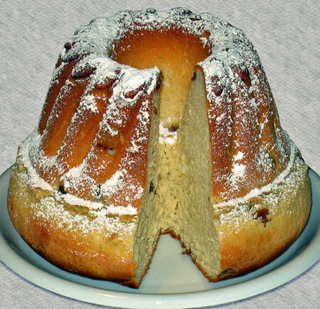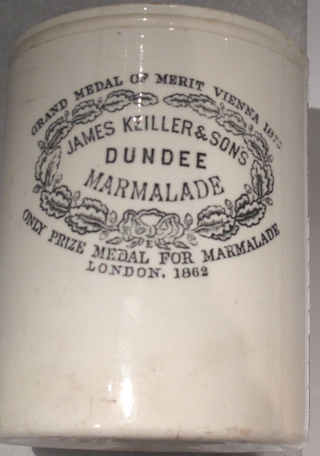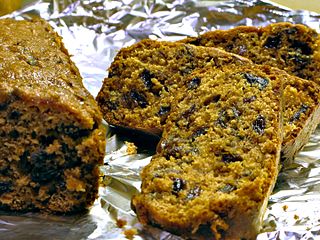 | |
| Type | Fruit cake |
|---|---|
| Place of origin | Scotland |
| Created by | Keiller's marmalade |
| Main ingredients | Currants, sultanas and almonds |
Dundee cake is a traditional Scottish fruit cake. [1] [2]
 | |
| Type | Fruit cake |
|---|---|
| Place of origin | Scotland |
| Created by | Keiller's marmalade |
| Main ingredients | Currants, sultanas and almonds |
Dundee cake is a traditional Scottish fruit cake. [1] [2]
Dundee cake often incorporates ingredients like butter, sugar, lemon zest, orange zest, marmalade, flour, baking powder, eggs, milk, dried fruit, glacé cherries, candied citrus peel, currants, sultanas, ground almonds, and finally blanched almonds as a decorative finish. [3]
The original commercial development of the cake began in Dundee in the late 18th century in the shop of Janet Keiller [4] but was possibly originally made for Mary, Queen of Scots in the 16th century. [5] It was mass-produced by the marmalade company Keiller's marmalade who have been claimed to be the originators of the term "Dundee cake". [6] However, similar fruit cakes were produced throughout Scotland. A popular story is that Mary Queen of Scots did not like glacé cherries in her cakes, so the cake was first made for her, as a fruit cake that used blanched almonds and not cherries. [7] The top of the cake is typically decorated with concentric circles of almonds. The cakes are sold in United Kingdom supermarkets.
The cake was also made and marketed in British India, and in independent India after 1947, by Britannia Industries and its successor firms. However, after 1980, the cake was withdrawn from the market though it continued to be supplied privately as a corporate Christmas gift by the maker.
Queen Elizabeth II was reported to favour Dundee cake at tea-time. [8]
In The Gathering Storm , Winston Churchill is depicted as a fan of the Dundee cake. [9]

Trifle is a layered dessert of English origin. The usual ingredients are a thin layer of sponge fingers or sponge cake soaked in sherry or another fortified wine, a fruit element, custard and whipped cream layered in that order in a glass dish. The contents of a trifle are highly variable and many varieties exist, some forgoing fruit entirely and instead using other ingredients, such as chocolate, coffee or vanilla. The fruit and sponge layers may be suspended in fruit-flavoured jelly, and these ingredients are usually arranged to produce three or four layers. The assembled dessert can be topped with whipped cream or, more traditionally, syllabub.

Marmalade is a fruit preserve made from the juice and peel of citrus fruits boiled with sugar and water. The well-known version is made from bitter orange. It is also made from lemons, limes, grapefruits, mandarins, sweet oranges, bergamots, and other citrus fruits, or a combination. Citrus is the most typical choice of fruit for marmalade, though historically the term has often been used for non-citrus preserves.

A scone is a traditional British baked good, popular in the United Kingdom and Ireland. It is usually made of either wheat flour or oatmeal, with baking powder as a leavening agent, and baked on sheet pans. A scone is often slightly sweetened and occasionally glazed with egg wash. The scone is a basic component of the cream tea. It differs from teacakes and other types of sweets that are made with yeast. Scones were chosen as the Republic of Ireland representative for Café Europe during the Austrian presidency of the European Union in 2006, while the United Kingdom chose shortbread.

Pound cake is a type of cake traditionally made with a pound of each of four ingredients: flour, butter, eggs, and sugar. Pound cakes are generally baked in either a loaf pan or a Bundt mold. They are sometimes served either dusted with powdered sugar, lightly glazed, or with a coat of icing.

Shortbread or shortie is a traditional Scottish biscuit usually made from one part white sugar, two parts butter, and three to four parts plain wheat flour. Shortbread does not contain any leavening, such as baking powder or baking soda. Shortbread is widely associated with Christmas and Hogmanay festivities in Scotland, and some Scottish brands are exported around the world.

A macaroon is a small cake or cookie, originally made from ground almonds, egg whites, and sugar, and now often with coconut or other nuts. They may also include jam or chocolate or other flavorings.

A Gugelhupf (also Kugelhupf, Guglhupf, Gugelhopf, pronounced[ˈɡuːɡl̩.hʊp͡f,-hɔp͡f,ˈkuːɡl̩-], and, in France, kouglof, kougelhof, or kougelhopf, is a cake traditionally baked in a distinctive ring pan, similar to Bundt cake, but leavened with baker's yeast.

Fruitcake or fruit cake is a cake made with candied or dried fruit, nuts, and spices, and optionally soaked in spirits. In the United Kingdom, certain rich versions may be iced and decorated.

The madeleine or petite madeleine is a traditional small cake from Commercy and Liverdun, two communes of the Lorraine region in northeastern France.

Genoa cake is a fruit cake consisting of sultanas, currants or raisins, glacé cherries, almonds, and candied orange peel or essence, cooked in a batter of flour, eggs, butter and sugar.

Scottish cuisine encompasses the cooking styles, traditions and recipes associated with Scotland. It has distinctive attributes and recipes of its own, but also shares much with other British and wider European cuisine as a result of local, regional, and continental influences—both ancient and modern.

Keiller's marmalade is named after its creators James and Janet Keiller, and is believed to have been the first commercial brand of marmalade in Great Britain. It was made by James Keiller in Dundee, Scotland, later creating James Keiller & Son, a brand name which became iconic in the 18th and 19th centuries, and has been sold several times.

Succade is the candied peel of any of the citrus species, especially from the citron or Citrus medica which is distinct with its extra-thick peel; in addition, the taste of the inner rind of the citron is less bitter than those of the other citrus. However, the term is also occasionally applied to the peel, root, or even entire fruit or vegetable like parsley, fennel and cucurbita which have a bitter taste and are boiled with sugar to get a special "sweet and sour" outcome.

Black bun, sometimes known as Scotch bun, is a type of fruit cake completely covered with pastry. It is Scottish in origin, originally eaten on Twelfth Night but now enjoyed at Hogmanay. The cake mixture typically contains raisins, currants, almonds, citrus peel, allspice, ginger, cinnamon and black pepper. It had originally been introduced following the return of Mary, Queen of Scots from France, but its original use at Twelfth Night ended with the Scottish Reformation. It was subsequently used for first-footing over Hogmanay.

A tea loaf is an English bread, made with dried fruit and traditionally served sliced and spread with butter. It is seen as a very traditional cake and the tea loaf is available in cafes and other establishments that serve traditional afternoon tea. It is particularly associated with Yorkshire.

Sponge cake is a light cake made with eggs, flour and sugar, sometimes leavened with baking powder. Some sponge cakes do not contain egg yolks, like angel food cake, but most of them do. Sponge cakes, leavened with beaten eggs, originated during the Renaissance, possibly in Spain. The sponge cake is thought to be one of the first non-yeasted cakes, and the earliest attested sponge cake recipe in English is found in a book by the English poet Gervase Markham, The English Huswife, Containing the Inward and Outward Virtues Which Ought to Be in a Complete Woman (1615). Still, the cake was much more like a cracker: thin and crispy. Sponge cakes became the cake recognised today when bakers started using beaten eggs as a rising agent in the mid-18th century. The Victorian creation of baking powder by English food manufacturer Alfred Bird in 1843 allowed the addition of butter to the traditional sponge recipe, resulting in the creation of the Victoria sponge. Cakes are available in many flavours and have many recipes as well. Sponge cakes have become snack cakes via the Twinkie.

Clementine cake is a cake flavored primarily with clementines. It may be topped with a sweet glaze or sauce, powdered sugar, honey and clementines, or candied clementines. It may originate from an orange cake in Sephardic cuisine. In popular culture, the cake played a minor part in the plot of the 2013 film The Secret Life of Walter Mitty.

Biscuit cake is a type of no bake tea cake, similar to American icebox cake, found in Irish, English, Danish, Arabic, Bulgarian and Jewish cuisine. It is made with digestive biscuits and is optionally prepared with a chocolate glaze.